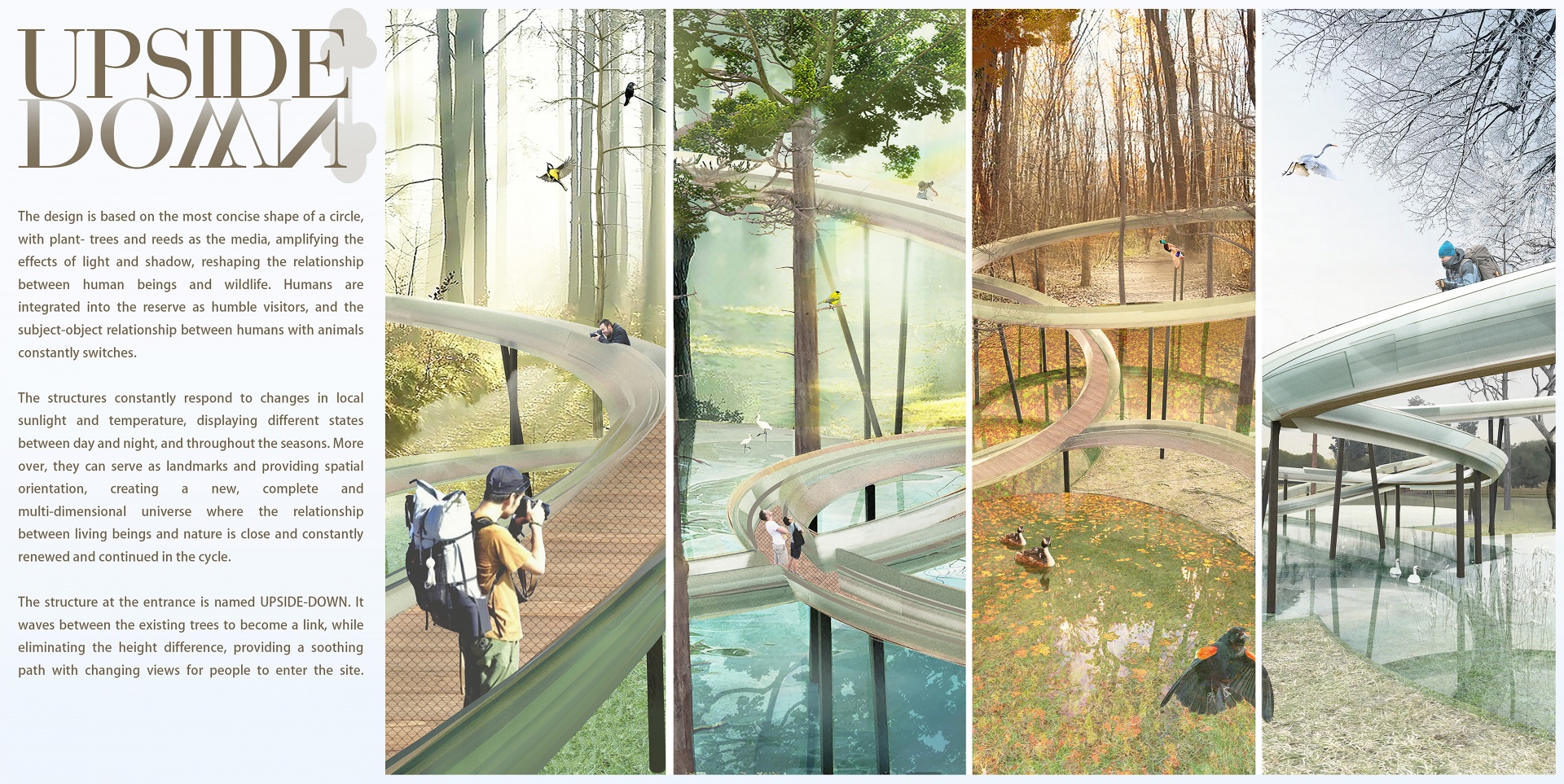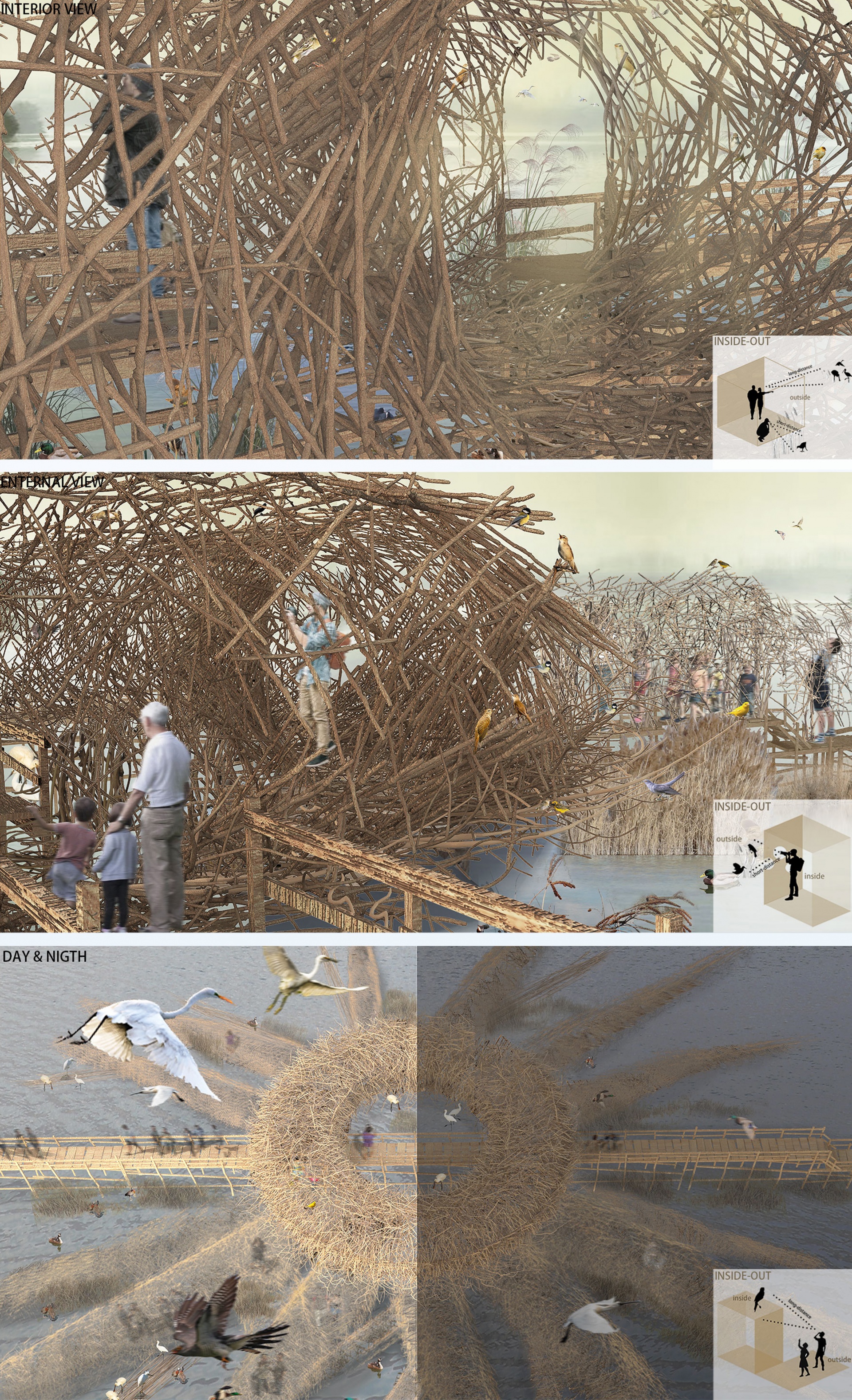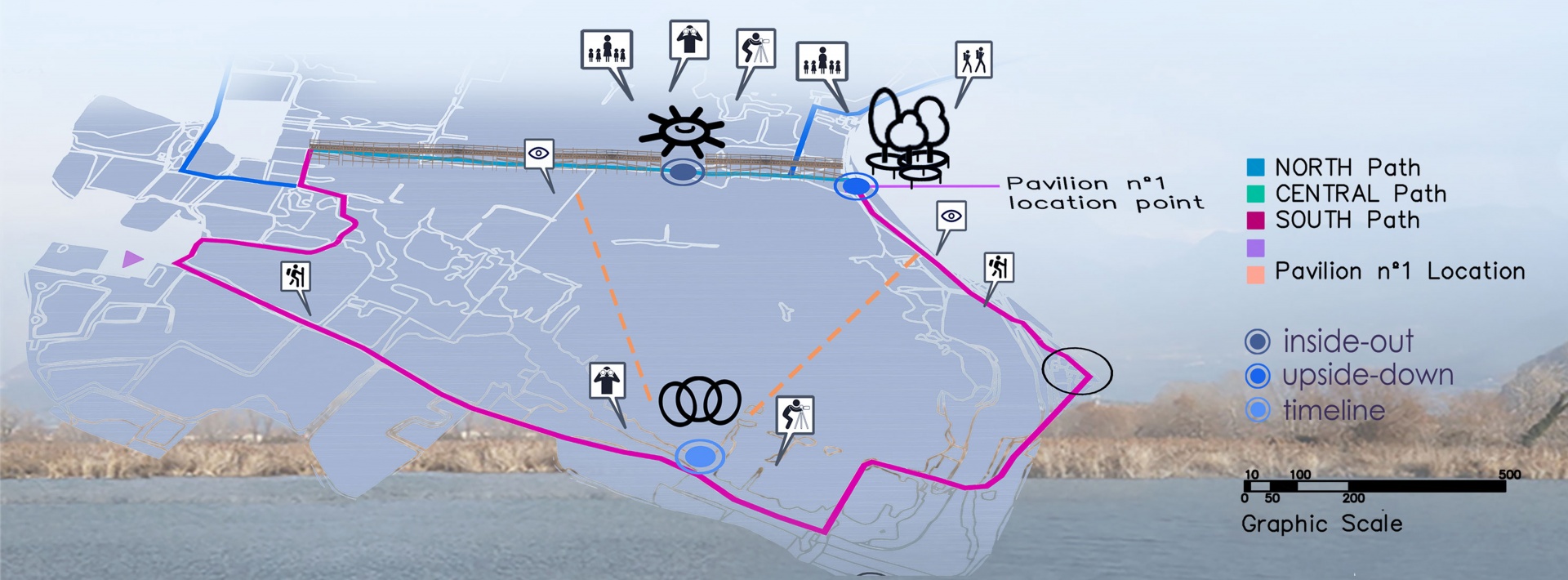设计理念:
设计以最简洁的圆形为基础形态,以植物—树木和芦苇作为媒介,重塑了人类与野生动物的关系。动物不再仅是被观察的对象,人类以谦逊的访客身份融入保护区,人和动物的主客体关系在游览过程中不断切换。构筑物时刻呼应着当地日照和温度的变化,放大光影变化的影响并展现出日夜、四季的不同状态。同时三个构筑物可以作为场地中的标志物,起到空间定位作用。以如上方式,三个构筑物创造出一个新的完整而多维度的系统,植物、动物、人类、环境和宇宙的联系更加密切,生物与自然关系密切,在循环中更新、延续。
中路入口处的构筑物名为upside-down,穿梭于既有的树之间成为纽带的同时消除了高差,为人提供了一条视野能够变换的舒缓路径以进入保护区。中路上的建筑名为inside-out,围合结构与其间的空隙互为表里,中心圆环可供人隐藏并停留,并向周边生长出一条条路径,既保障了人与鸟之间有充足的距离,又为人观察水面上的鸟提供了中路以外的独特视角。第三个构筑物timeline位于场地南部的湖泊边,该导视物利用木材创造巧妙的透视效果,引导人们在此眺望优美的湖光山色。构筑物见证着时间作用下自然的变换,串联起场地中的时间与空间。
The design is based on the most concise shape of a circle, with plant- trees and reeds as the media, amplifying the effects of light and shadow, reshaping the relationship between human beings and wildlife. Humans are integrated into the reserve as humble visitors, and the subject-object relationship between humans with animals constantly switches. The structures constantly respond to changes in local sunlight and temperature, displaying different states between day and night, and throughout the seasons. More over, they can serve as landmarks and providing spatial orientation, creating a new, complete and multi-dimensional universe where the relationship between living beings and nature is close and constantly renewed and continued in the cycle.
The structure at the entrance is named UPSIDE-DOWN. It waves between the existing trees to become a link, while eliminating the height difference, providing a soothing path with changing views for people to enter the site. The construction on the central path is called INSIDE-OUT, the enclosed structure and its gaps complement each other, the central circular ring can be used for people to hide and stay, while growing out paths towards the surrounding area. It not only ensures sufficient distance between people and birds but also provides a unique perspective for observation. The third structure, TIMELINE,is located on the southern lakefront of the side, using light metal, the wayfinding element creates clever perspective effects, guiding people to admire beautiful lake and mountain scenery. The structure witnesses the natural changes, connecting the site’s time and space.
中路入口处的构筑物名为upside-down,穿梭于既有的树之间成为纽带的同时消除了高差,为人提供了一条视野能够变换的舒缓路径以进入保护区。中路上的建筑名为inside-out,围合结构与其间的空隙互为表里,中心圆环可供人隐藏并停留,并向周边生长出一条条路径,既保障了人与鸟之间有充足的距离,又为人观察水面上的鸟提供了中路以外的独特视角。第三个构筑物timeline位于场地南部的湖泊边,该导视物利用木材创造巧妙的透视效果,引导人们在此眺望优美的湖光山色。构筑物见证着时间作用下自然的变换,串联起场地中的时间与空间。
The design is based on the most concise shape of a circle, with plant- trees and reeds as the media, amplifying the effects of light and shadow, reshaping the relationship between human beings and wildlife. Humans are integrated into the reserve as humble visitors, and the subject-object relationship between humans with animals constantly switches. The structures constantly respond to changes in local sunlight and temperature, displaying different states between day and night, and throughout the seasons. More over, they can serve as landmarks and providing spatial orientation, creating a new, complete and multi-dimensional universe where the relationship between living beings and nature is close and constantly renewed and continued in the cycle.
The structure at the entrance is named UPSIDE-DOWN. It waves between the existing trees to become a link, while eliminating the height difference, providing a soothing path with changing views for people to enter the site. The construction on the central path is called INSIDE-OUT, the enclosed structure and its gaps complement each other, the central circular ring can be used for people to hide and stay, while growing out paths towards the surrounding area. It not only ensures sufficient distance between people and birds but also provides a unique perspective for observation. The third structure, TIMELINE,is located on the southern lakefront of the side, using light metal, the wayfinding element creates clever perspective effects, guiding people to admire beautiful lake and mountain scenery. The structure witnesses the natural changes, connecting the site’s time and space.












